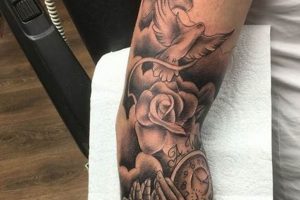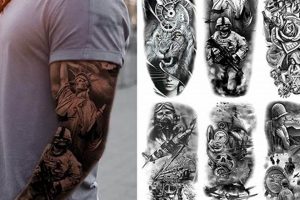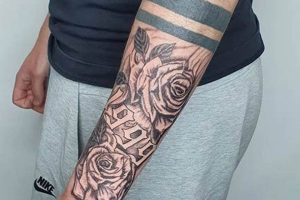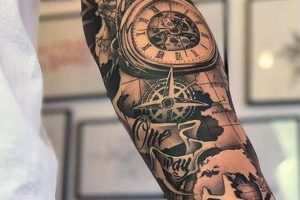A half-sleeve tattoo, extending from the shoulder to the elbow, offers a substantial canvas for intricate artwork. When inspired by Japanese aesthetics, these tattoos often incorporate elements such as koi fish, dragons, cherry blossoms, samurai, geishas, or oni masks, interwoven with traditional Japanese wave patterns and other symbolic imagery. Examples include a vibrant depiction of a dragon ascending Mount Fuji amidst swirling clouds or a serene arrangement of koi fish swimming amongst lotus flowers and flowing water.
The enduring appeal of this tattoo style stems from its rich history and deeply symbolic nature. Japanese tattooing, known as Irezumi, boasts a centuries-old tradition, carrying significant cultural and spiritual meaning. Choosing this style allows individuals to express personal narratives, beliefs, or aspirations through visually striking and culturally resonant art forms. The half-sleeve placement provides a balance between showcasing detailed designs and maintaining flexibility in terms of visibility and social contexts.
Exploring specific motifs, their symbolic meanings, and variations in artistic styles (like traditional, neo-traditional, and modern) can further assist in the creation of a personalized and meaningful design. Understanding the process, commitment, and aftercare involved is equally crucial for anyone considering a Japanese-inspired half-sleeve tattoo.
Tips for Choosing Japanese Half-Sleeve Tattoo Designs
Careful consideration is essential when selecting a Japanese-inspired half-sleeve tattoo design. The following tips offer guidance for navigating this process.
Tip 1: Research Symbolism: Thorough research into the cultural and historical significance of chosen motifs is paramount. A dragon, for example, can represent wisdom and strength, while a cherry blossom embodies the ephemeral nature of life.
Tip 2: Consider Placement and Flow: The curvature of the arm and the natural flow of the chosen design elements should be considered for a cohesive and aesthetically pleasing result. Certain elements, like dragons, lend themselves well to wrapping around the arm.
Tip 3: Choose a Reputable Artist: Selecting a skilled artist specializing in Japanese tattooing ensures accurate representation of traditional motifs and techniques. Review portfolios and consult with potential artists to discuss design ideas.
Tip 4: Plan for Multiple Sessions: Intricate half-sleeve designs often require multiple sessions to complete. This allows for proper healing and detailed execution of the artwork.
Tip 5: Budget Accordingly: High-quality, large-scale tattoos represent a significant investment. Establish a budget beforehand to avoid compromising on the quality of the artwork or rushing the process.
Tip 6: Think Long-Term: Tattoos are permanent. Thoroughly consider the chosen design and its implications before committing. Avoid impulsive decisions based on fleeting trends.
Tip 7: Prioritize Aftercare: Proper aftercare is crucial for healing and preserving the vibrancy of the tattoo. Follow the artist’s instructions diligently.
By following these guidelines, individuals can ensure a meaningful, well-executed, and culturally respectful Japanese-inspired half-sleeve tattoo that will be appreciated for years to come.
Ultimately, the journey of selecting and receiving a Japanese half-sleeve tattoo is a personal one. These tips provide a foundation for making informed decisions and achieving a result that reflects individual style and appreciation for this rich art form.
1. Traditional Japanese Motifs
Traditional Japanese motifs form the core of authentic Japanese half-sleeve tattoo designs. These motifs, steeped in symbolism and history, offer a rich visual language for self-expression. Their inclusion elevates a tattoo beyond mere aesthetics, imbuing it with cultural significance and narrative depth. Understanding the meaning behind these motifs is crucial for creating a cohesive and resonant design. For instance, a dragon, often associated with strength and wisdom, might be paired with cherry blossoms, symbolizing the transient nature of life, to create a powerful juxtaposition of opposing yet complementary forces.
Specific examples illustrate this connection further. A half-sleeve featuring a samurai alongside a tiger represents courage and nobility. Incorporating waves and koi fish evokes themes of resilience and prosperity. The selection and arrangement of these motifs narrate a story, reflecting personal values or experiences. The meticulous detail and vibrant colors characteristic of Japanese art further enhance the visual impact. Careful consideration of these elements ensures a design that is both aesthetically striking and culturally informed.
Ultimately, the power of Japanese half-sleeve tattoos lies in the thoughtful integration of traditional motifs. This practice respects the rich heritage of Japanese tattooing while allowing for personal interpretation. Appreciating the symbolism behind each element ensures a design that resonates deeply with its wearer and holds lasting meaning. Selecting motifs based on personal significance transforms the tattoo into a powerful statement of identity and belief.
2. Color Symbolism and Palette
Color symbolism plays a vital role in Japanese half-sleeve tattoo designs, adding layers of meaning and visual depth. Specific colors hold cultural significance, influencing the overall interpretation of the tattoo. Red, often associated with passion, power, and good fortune, might be used to depict a fiery dragon or the rising sun. Black, representing protection, mystery, and elegance, often outlines figures or forms the backdrop for other elements. Choosing the right palette is crucial for effectively conveying the intended message and respecting traditional conventions. For instance, a vibrant koi fish rendered in shades of red and orange, accented with black and gold, suggests prosperity and good luck.
The interplay of colors further enhances the symbolic narrative. A half-sleeve depicting a serene landscape with a blue and green color scheme symbolizes tranquility and harmony with nature. Conversely, a tattoo featuring a fierce warrior rendered in deep reds and blacks conveys strength and power. The use of contrasting colors, like red and black or blue and gold, creates visual interest and adds symbolic weight. Subtle color gradations and shading techniques, characteristic of Japanese art, create depth and dimension within the design. This attention to color detail elevates the tattoo beyond mere decoration, transforming it into a powerful expression of personal and cultural values.
Understanding color symbolism is therefore essential for creating a meaningful and aesthetically balanced Japanese half-sleeve tattoo. Careful color selection amplifies the symbolism of chosen motifs, strengthening the overall narrative. This understanding allows for a deeper appreciation of the art form and ensures a design that resonates on both visual and symbolic levels. Ignoring color significance risks misinterpreting traditional conventions and diluting the intended message. Thus, thoughtful color consideration is paramount for achieving a truly authentic and impactful design.
3. Placement and Body Flow
Placement and body flow are integral to the success of Japanese half-sleeve tattoo designs. The natural curves of the arm and shoulder provide a dynamic canvas, and the design should complement these contours rather than fight against them. A well-placed design considers the body’s movement, ensuring the artwork flows seamlessly with the wearer’s form. For instance, a dragon might be positioned to wrap around the arm, its body following the natural muscle lines, creating a sense of movement and power. Conversely, a static design placed awkwardly can appear disjointed and detract from the overall aesthetic. This careful consideration of placement enhances the visual impact and contributes to the tattoo’s overall harmony.
Specific examples further illustrate this principle. A flowing river scene, incorporating elements like koi fish and water ripples, can be strategically placed to follow the contours of the forearm, creating a sense of natural movement. Cherry blossoms cascading down the shoulder and upper arm mimic the way they fall from branches in nature. A fierce samurai might be positioned prominently on the outer bicep, conveying a sense of strength and readiness. This attention to placement transforms the tattoo from a static image into a dynamic piece of art, integrated with the body itself. It underscores the artist’s skill and the wearer’s appreciation for the art form.
Successful Japanese half-sleeve tattoos prioritize the interplay between design and body flow. This approach ensures the tattoo complements the wearer’s physique, enhancing its aesthetic appeal. Ignoring this principle can result in a visually jarring and disjointed tattoo, detracting from its intended impact. Therefore, understanding the importance of placement is paramount for creating a visually stunning and harmonious piece of body art that truly integrates with the individual. This synergy between art and anatomy elevates the tattoo to a higher level of artistry and personal expression.
4. Artist Selection and Expertise
Artist selection represents a critical decision when considering a Japanese half-sleeve tattoo. The intricate detail, symbolic depth, and stylistic nuances inherent in these designs necessitate a skilled artist with specialized knowledge. A deep understanding of Japanese art, culture, and tattooing traditions ensures accurate representation of chosen motifs and appropriate application of techniques. An experienced artist possesses the technical skill to execute clean lines, vibrant colors, and smooth shading, essential for a high-quality, long-lasting tattoo. Choosing an artist solely based on price or proximity, rather than expertise, can lead to a subpar result, potentially misrepresenting cultural symbols or compromising the aesthetic integrity of the design. For instance, an unskilled artist might misinterpret the flow of a dragon’s body or incorrectly depict the scales of a koi fish, diminishing the tattoo’s visual impact and cultural significance.
Practical implications underscore the importance of selecting a qualified artist. A skilled artist guides clients through the design process, offering expert advice on motif selection, placement, and color palettes. They understand the importance of body flow and how to integrate the design seamlessly with the wearer’s physique. This collaborative approach ensures the final result aligns with the client’s vision while respecting traditional Japanese aesthetics. Furthermore, experienced artists prioritize hygiene and safety, using sterilized equipment and adhering to proper aftercare procedures, minimizing the risk of complications. Investing time and research in finding a reputable artist specializing in Japanese tattooing ultimately ensures a meaningful, well-executed, and culturally respectful piece of art.
In conclusion, artist selection significantly impacts the quality and authenticity of Japanese half-sleeve tattoos. Expertise in Japanese art and tattooing traditions is essential for accurate rendering of motifs, proper application of techniques, and respectful representation of cultural symbolism. Prioritizing artist selection ensures a visually stunning and culturally significant piece of body art that will be valued for years to come. Failing to recognize the importance of expertise can result in a disappointing and potentially culturally insensitive outcome, highlighting the crucial link between artist selection and the successful execution of Japanese-inspired tattoo designs.
5. Personal Meaning and Narrative
Japanese half-sleeve tattoos offer a powerful medium for expressing personal narratives and imbuing designs with individual meaning. While traditional motifs possess established symbolism, their incorporation into a half-sleeve composition allows for personalized interpretations and unique storytelling. The selection and arrangement of elements, combined with stylistic choices, create a visual narrative reflecting the wearer’s values, experiences, or aspirations. For example, a phoenix rising from flames could symbolize overcoming adversity, while a dragon intertwined with cherry blossoms might represent the balance between strength and beauty. This integration of personal meaning elevates the tattoo beyond a decorative element, transforming it into a powerful statement of identity.
The narrative potential of Japanese half-sleeve tattoos extends beyond individual motifs. The overall composition, color palette, and background elements contribute to the storytelling. A half-sleeve depicting a serene landscape with a calming color scheme might reflect a desire for inner peace, while a dynamic portrayal of battling samurai could symbolize resilience and determination. Practical applications include commemorating significant life events, honoring loved ones, or expressing deeply held beliefs. A half-sleeve featuring a family crest alongside protective deities could represent familial devotion and heritage. The ability to weave personal narratives into these designs transforms the tattooing process into a deeply meaningful and transformative experience.
Ultimately, the fusion of personal meaning and narrative with Japanese half-sleeve tattoo designs imbues these artworks with profound significance. This approach moves beyond simply adorning the body; it becomes an act of self-expression and storytelling. The wearer’s narrative intertwines with the rich symbolism of Japanese art, resulting in a unique and powerful visual representation of personal identity. Recognizing this connection allows for a deeper appreciation of the art form and its potential for conveying complex and deeply personal messages. This understanding transforms the tattoo into a tangible embodiment of individual experiences, beliefs, and aspirations.
Frequently Asked Questions
This section addresses common inquiries regarding Japanese half-sleeve tattoos, offering factual information and dispelling potential misconceptions.
Question 1: How much does a Japanese half-sleeve tattoo typically cost?
Pricing varies depending on the artist’s experience, the complexity of the design, and the number of sessions required. Generally, one can expect a significant investment for a high-quality, custom piece.
Question 2: How long does it take to complete a Japanese half-sleeve tattoo?
Completion time depends on the design’s intricacy and the individual’s pain tolerance. Multiple sessions, spaced weeks apart for healing, are typically necessary, potentially spanning several months or even a year.
Question 3: Is it culturally insensitive to get a Japanese tattoo if one is not of Japanese heritage?
Respectful appreciation and understanding of Japanese culture are crucial. Thorough research of chosen motifs and consultation with a knowledgeable artist demonstrates cultural sensitivity.
Question 4: What is the best placement for a Japanese half-sleeve tattoo?
Placement depends on personal preference and the design’s flow. The natural curves of the arm and shoulder offer a dynamic canvas; designs should complement these contours for optimal aesthetic impact.
Question 5: How should one care for a Japanese half-sleeve tattoo during the healing process?
Following the artist’s aftercare instructions diligently is crucial for proper healing and color retention. This typically involves keeping the tattoo clean, moisturized, and protected from sun exposure.
Question 6: Can a Japanese half-sleeve tattoo be covered up if needed?
While technically possible, covering a large, detailed tattoo is challenging and depends on the design’s colors and the wearer’s skin tone. Careful consideration of long-term visibility is recommended before commitment.
Understanding these aspects contributes to informed decision-making and ensures a positive experience. Thorough research, careful planning, and consultation with a reputable artist are essential steps in acquiring a meaningful and well-executed Japanese half-sleeve tattoo.
Further exploration of specific motifs, artist portfolios, and aftercare practices provides additional guidance for individuals considering this impactful art form. This continued research empowers informed decisions and fosters a deeper appreciation for the rich traditions of Japanese tattooing.
Japanese Half Sleeve Tattoo Ideas
Exploring Japanese half sleeve tattoo ideas requires careful consideration of various interconnected elements. From the symbolic weight of traditional motifs like dragons, koi fish, and cherry blossoms to the significance of color palettes and the importance of harmonious placement along the contours of the arm, each aspect contributes to the overall impact and cultural resonance. Selecting a skilled artist specializing in Japanese tattooing is paramount, ensuring accurate representation of chosen motifs and proper execution of intricate details. Furthermore, imbuing the design with personal meaning transforms the tattoo into a powerful narrative reflecting individual values, experiences, or aspirations. The commitment involved necessitates thorough research, thoughtful planning, and a deep appreciation for the rich history and cultural significance of Japanese tattoo art.
Japanese half sleeve tattoos represent more than mere body decoration; they serve as powerful statements of personal identity and cultural appreciation. The enduring appeal of this art form lies in its ability to weave together intricate artistry, symbolic depth, and personal narratives, creating a lasting testament to individual expression. The journey toward acquiring a Japanese half sleeve tattoo demands careful consideration and informed decision-making, resulting in a meaningful and visually striking piece of art that resonates with both the wearer and those who appreciate its rich cultural heritage.







